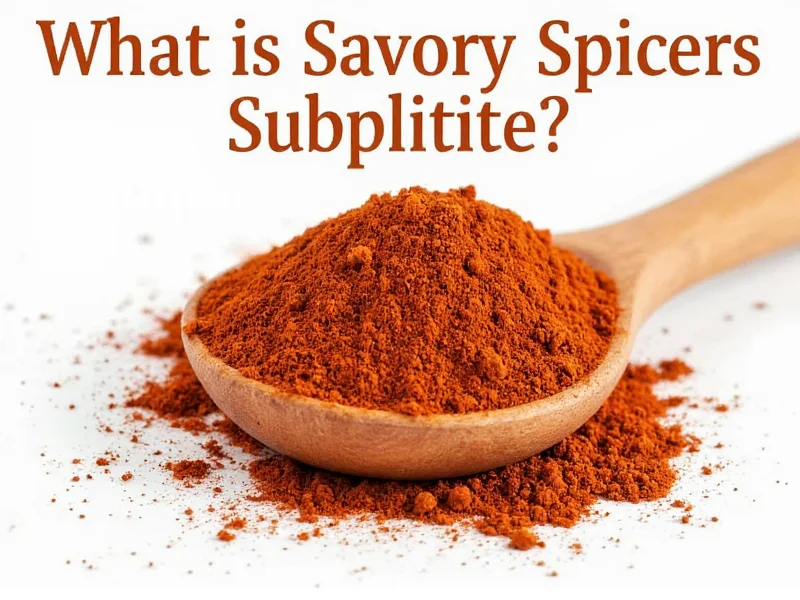Understanding savory spice substitutes is essential for both novice and experienced cooks facing ingredient limitations. Whether you're accommodating dietary restrictions, dealing with pantry shortages, or experimenting with flavor profiles, knowing effective replacements keeps your culinary creations on track. Savory spices—those enhancing umami and earthy notes rather than sweet profiles—form the backbone of countless global cuisines, from Italian herb blends to Indian curry mixes.
Why Substitute Savory Spices?
Cooks seek savory spice alternatives for several practical reasons. Allergies and sensitivities often necessitate substitutions, particularly for common allergens like garlic or onion powder. Religious dietary restrictions may require alternatives to certain spice blends. Pantry emergencies occur when a recipe calls for a specific spice you've run out of. Health considerations drive many to seek lower-sodium options or substitutes without additives. Additionally, regional availability issues mean certain spices simply aren't accessible in all locations.
Principles of Effective Spice Substitution
Successful savory spice substitution follows three fundamental principles. First, understand flavor profiles—savory spices generally fall into categories like herbal, earthy, pungent, or umami-rich. Second, consider potency differences; dried spices are typically three times stronger than fresh equivalents. Third, account for texture and moisture content, especially when substituting fresh for dried ingredients. For instance, when replacing fresh garlic with garlic powder, use 1/8 teaspoon powder for each clove of fresh garlic to avoid overpowering your dish.
Comprehensive Savory Spice Substitution Guide
| Original Spice | Best Substitute | Substitution Ratio | Notes |
|---|---|---|---|
| Cumin | Coriander + Paprika | 1 tsp cumin = 1/2 tsp coriander + 1/4 tsp paprika | Add pinch of chili powder for smokiness |
| Cayenne Pepper | Smoked Paprika | 1/4 tsp cayenne = 1/2 tsp smoked paprika | Milder heat with smoky flavor |
| Garlic Powder | Onion Powder + Asafoetida | 1 tsp garlic = 1 tsp onion + 1/8 tsp asafoetida | For garlic allergies; use sparingly |
| Dried Thyme | Oregano | 1 tsp thyme = 3/4 tsp oregano | More pungent; works well in Mediterranean dishes |
| Celery Seed | Celery Salt | 1 tsp seed = 1/2 tsp celery salt | Reduce additional salt in recipe |
| Fennel Seed | Dill Seed + Anise | 1 tsp fennel = 1/2 tsp dill + 1/4 tsp anise | For sausage recipes and Italian dishes |
Detailed Substitution Recommendations
When substituting for cumin—a cornerstone of Mexican and Indian cuisines—combine coriander and paprika to approximate its earthy warmth. For recipes requiring the sharp heat of cayenne pepper, smoked paprika provides comparable color with milder heat, making it ideal for those sensitive to spice intensity. Garlic powder substitutions become crucial for individuals with allium sensitivities; the combination of onion powder and asafoetida (hing) delivers similar savory depth without triggering digestive issues.
Herbal substitutions require particular attention to flavor profiles. Dried thyme's subtle earthiness works in countless applications, but oregano makes an excellent stand-in with its more pronounced flavor—just use slightly less to prevent overpowering your dish. For celery seed, which provides distinctive flavor in coleslaw and pickling recipes, celery salt works well but remember to adjust overall salt content in your recipe accordingly.
Dietary-Specific Savory Alternatives
Low-sodium cooking demands creative savory spice solutions. Replace seasoned salt blends with herb-infused vinegar sprays or citrus zest. For gluten-free requirements, verify that spice blends don't contain wheat-based fillers—many commercial blends do. Those following histamine-restricted diets should avoid fermented spice blends and opt for fresh herbs instead. Vegan cooks seeking umami depth without fish sauce can use mushroom powder or nutritional yeast as excellent savory alternatives.
Avoiding Common Substitution Mistakes
Many home cooks make critical errors when substituting savory spices. The most frequent mistake involves ignoring potency differences between fresh and dried ingredients. Another common error is substituting sweet spices like cinnamon or nutmeg in savory applications, which creates unbalanced flavor profiles. Some cooks overlook how substitutions affect cooking time—fresh herbs generally should be added later in the cooking process than dried spices. Remember that some substitutions work better in specific cuisines; what works in Italian cooking might not translate well to Asian dishes.
Creating Your Own Custom Blends
When commercial spice blends aren't suitable, creating your own custom savory mixtures ensures control over ingredients. For a versatile all-purpose savory blend, combine equal parts onion powder, garlic powder, dried thyme, and black pepper. Add smoked paprika for depth or nutritional yeast for cheesy umami notes. Store homemade blends in airtight containers away from light and heat to preserve flavor integrity. Properly stored, most custom blends maintain potency for 6-12 months.











 浙公网安备
33010002000092号
浙公网安备
33010002000092号 浙B2-20120091-4
浙B2-20120091-4